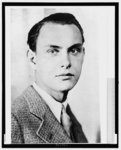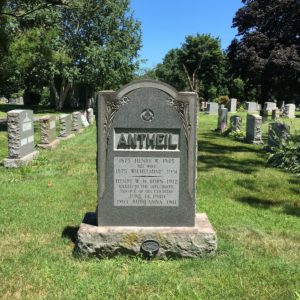The name Henry Antheil, Jr, is on a tombstone in Riverview Cemetery, but he is not buried there. Henry, the younger brother of avant-garde composer George Antheil, was a Trenton, New Jersey native who joined the U.S. Foreign service as a cipher clerk and was posted in Helsinki, Finland, at the beginning of World War II. Henry Antheil, Jr., could be considered an early American casualty of both World War II and the Cold War.

As the Nazis advanced on Paris, the Soviet Union moved towards taking over the Baltic country of Estonia. On June 14, 1940, the 27 year old Antheil was sent to pick up several diplomatic pouches from the American legation in Estonia’s capital. He then boarded a Finnish commercial airplane, the Kaleva, to return to Finland. Less than ten minutes after the Kaleva took off from Estonia, two Soviet bombers intercepted it and shot it out of the sky. Almost immediately, a Soviet submarine arrived at the crash location and seized the diplomatic pouches. There were no survivors. The plane has never been recovered.

Although the attack was witnessed by Estonian fishermen, news reports at the time made no mention of the Soviet attack, reporting that the plane “mysteriously exploded” over the water. The Soviets invaded Estonia a couple of days later. The Finnish government, fearful of Soviet aggression, remained quiet about the incident until the Soviet Union invaded their country, too.
What was in the diplomatic pouches? They likely included American code books. Some think the Americans had also obtained the details of a secret agreement between Soviet Union and Nazi Germany. In 1939 the two countries had signed a neutrality agreement, the Molotov-Ribbentrop Pact. At the same time, they had secretly agreed to divide up much of northern Europe between the two of them, with the Soviets getting Estonia and Finland.
Henry’s brother, George, was a prominent musician, composer, and self-proclaimed “bad boy of music.” By the late 1930s, he had transitioned to scoring music for Hollywood films, but also wrote for Esquire magazine. In 1939, George published “Germany Never Had a Chance,” in which predicted the forthcoming world war and how the Nazis would eventually be defeated. One source for that article was his brother, Henry. George later wrote that when the two were together in Trenton that year, they had discussed politics. Hitler would “have his teeth kicked in,” Henry had asserted. “The reason is that the damned fool will attack Russia…This may finish him off, but I’m afraid not. I think we’ll eventually have to get in. Russia’s strong, but not quite strong enough.”
Not long after his brother was killed, George would meet actress Hedy Lamarr (that meeting was triggered by a completely different Esquire article George had written). Both wanted to do something to help America’s fight against fascism. That meeting resulted in their now-famous collaboration on a secret torpedo guidance system Lamarr called frequency hopping.
Selected References:
Antheil, George
1945 Bad Boy of Music. Doubleday, Doran, and Co. New York.
Shearer, Steven Michael
2010 Beautiful: The Life of Hedy Lamarr. Thomas Dunne Books, St. Martin’s Press, New York.
